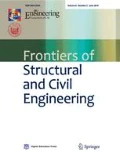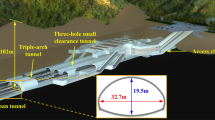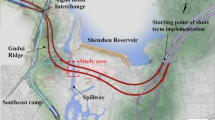Abstract
The Xiamen Haicang double-arch tunnel has a maximum span of 45.73 m and a minimum burial depth of 5.8 m. A larger deformation or collapse of the tunnel is readily encountered during tunnel excavation. It is therefore necessary to select a construction approach that is suitable for double-arch tunnel projects with an extra-large span. In this study, three construction methods for double-arch tunnels with extra-large spans were numerically simulated. Subsequently, the deformation behavior and stress characteristics of the surrounding rock were obtained and compared. The results showed that the double-side-drift method with temporary vertical support achieves better adaptability in the construction of such tunnels, which can be observed from both the numerical results and in situ monitoring data. In addition, the improved temporary support plays a critical role in controlling the surrounding rock deformation. In addition, the disturbance resulting from the excavation of adjacent drifts was obvious, particularly the disturbance of the surrounding rock caused by the excavation of the middle drift. The present findings can serve as the initial guidelines for the construction of ultra-shallowly buried double-arch tunnels with extra-large spans.
Similar content being viewed by others
References
Li S, Yuan C, Feng X, Li S. Mechanical behaviour of a large-span double-arch tunnel. KSCE Journal of Civil Engineering, 2016, 20(7): 2737–2745
Wang S, Li C, Wang Y, Zou Z. Evolution characteristics analysis of pressure-arch in a double-arch tunnel. Tehnicki Vjesnik-Technical Gazette, 2016, 23: 181–189
Li P, Zhao Y, Zhou X. Displacement characteristics of high-speed railway tunnel construction in loess ground by using multi-step excavation method. Tunnelling and Underground Space Technology, 2016, 51: 41–55
Zhou S, Zhuang X, Rabczuk T. Phase-field modeling of fluid-driven dynamic cracking in porous media. Computer Methods in Applied Mechanics and Engineering, 2019, 350: 169–198
Li P, Zhao Y. Performance of a multi-face tunnel excavated in loess ground based on field monitoring and numerical modeling. Arabian Journal of Geosciences, 2016, 9(14): 640
Zhou S, Zhuang X, Rabczuk T. Phase field modeling of brittle compressive-shear fractures in rock-like materials: A new driving force and a hybrid formulation. Computer Methods in Applied Mechanics and Engineering, 2019, 355: 729–752
Sharifzadeh M, Kolivand F, Ghorbani M, Yasrobi S. Design of sequential excavation method for large span urban tunnels in soft ground-Niayesh tunnel. Tunnelling and Underground Space Technology, 2013, 35: 178–188
Zhou S, Rabczuk T, Zhuang X. Phase field modeling of quasi-static and dynamic crack propagation: COMSOL implementation and case studies. Advances in Engineering Software, 2018, 122: 31–49
Zhou S, Zhuang X, Rabczuk T. A phase-field modeling approach of fracture propagation in poroelastic media. Engineering Geology, 2018, 240: 189–203
Zhou S, Zhuang X, Zhu H, Rabczuk T. Phase field modelling of crack propagation, branching and coalescence in rocks. Theoretical and Applied Fracture Mechanics, 2018, 96: 174–192
Zhao X, Chen H, Wang C. Resistance of large deformation of the Wushaoling Tunnel F7 soft fault. Frontiers of Architecture and Civil Engineering in China, 2007, 1(1): 123–127
Gao F, Xue D. Double-arch tunnel construction in large span bias weak surrounding rock. Journal of Chongqing Jiaotong University (Natural Science), 2014, 33: 30–34
Yang J, Gou D, Zhang Y. Field measurements and numerical analyses of double-layer pipe roof reinforcement in a shallow multiarch tunnel. Transportation Research Record: Journal of the Transportation Research Board, 2008, 2050(1): 145–153
Bai J, Zhao S, Qi B, Yang K. Study on the structure deformation of large-span shallow-buried multi-arch tunnel in soft stratum. China Civil Engineering Journal, 2017, 50: 45–50
Yang K, Dong F, Zhang Y, Zhang Z, Huang J. Study on the key technology of urban large span double arch tunnel using drilling and blasting method. Technology of Highway and Transport, 2018, 34: 24–32 (in Chinese)
Zhang Y, Shi Y, Zhao Y, Fu L, Yang J. Determining the cause of damages in a multiarch tunnel structure through field investigation and numerical analysis. Journal of Performance of Constructed Facilities, 2017, 31(3): 04016104
Wei J, Sun S. Ground Settlement Model for Excavation of a Non-Partial Pressure and Shallow Buried Double-Arch Tunnel. Berlin, Heidelberg: Springer, 2008
Shen Y, Zhao Y, Zhang H, Guo W, Lin Z, Wan Y, Zhang H, Li Z. Numerical analysis of elastoplastic finite element in construction of twin-arch tunnel. Chinese Journal of Rock Mechanics and Engineering, 2004, S2: 4946–4951 (in Chinese)
Wang J, Xia C, Zhu H, Li Y, Lin Z, Chen X. Site monitoring and analysis of non-symmetrical multi-arch highway tunnel. Chinese Journal of Rock Mechanics and Engineering, 2004, 2: 267–271 (in Chinese)
Ji M, Wu S, Gao Y, Ge L, Li X. Construction monitoring and numerical simulation of multi-arch tunnel. Rock and Soil Mechanics, 2011, 32: 3787–3795 (in Chinese)
Dong J. Xiamen second west passage project. Tunnel Construction, 2019, 39(5): 890–897 (in Chinese)
Karakus M, Fowell R. Effects of different tunnel face advance excavation on the settlement by FEM. Tunnelling and Underground Space Technology, 2003, 18(5): 513–523
Wang Y, Xin Y, Xie Y, Li J, Wang Z. Investigation of mechanical performance of prestressed steel arch in tunnel. Frontiers of Structural and Civil Engineering, 2017, 11(3): 360–367
Kong F, Shang J. A validation study for the estimation of uniaxial compressive strength based on index tests. Rock Mechanics and Rock Engineering, 2018, 51(7): 2289–2297
Acknowledgements
Much of the research presented in this paper was supported by the National Natural Science Foundations of China (Grant Nos. 51379112, 51422904, 40902084, 41772298, and 41877239), the Fundamental Research Funds for the Central Universities (No. 2018JC044), and the Shandong Provincial Natural Science Foundation (No. JQ201513).
Author information
Authors and Affiliations
Corresponding author
Rights and permissions
About this article
Cite this article
Xue, Y., Gong, H., Kong, F. et al. Stability analysis and optimization of excavation method of double-arch tunnel with an extra-large span based on numerical investigation. Front. Struct. Civ. Eng. 15, 136–146 (2021). https://doi.org/10.1007/s11709-020-0710-8
Received:
Accepted:
Published:
Issue Date:
DOI: https://doi.org/10.1007/s11709-020-0710-8




